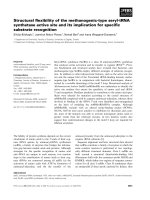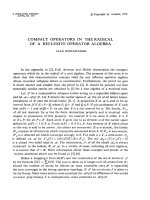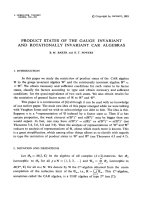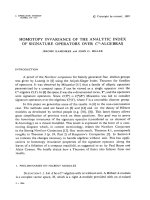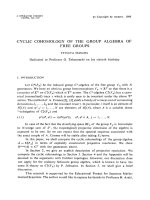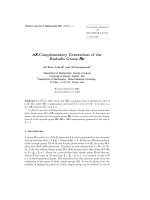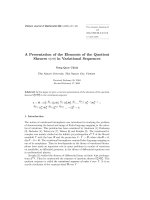Báo cáo toán học: "nX-Complementary Generations of the Rudvalis Group Ru Ali Reza Ashrafi1 and Ali Iranmanesh2" docx
Bạn đang xem bản rút gọn của tài liệu. Xem và tải ngay bản đầy đủ của tài liệu tại đây (111.66 KB, 7 trang )
Vietnam Journal of Mathematics 33:1 (2005) 1–7
nX-Complementary Generations of the
Rudvalis Group Ru
Ali Reza Ashrafi
1
and Ali Iranmanesh
2
1
Department of Mathematics, Faculty of Science,
University of Kashan, Kashan, Iran
2
Department of Mathematics, Tarbiat Modarre s University,
P.O.Box: 14115-137, Tehran, Iran
Received March 19, 2003
Revised October 17, 2004
Abstract Let G be a finite group and nX a conjugacy class of elements of order n
in G. G is called nX−complementary generated if, for every x ∈ G −{1},thereisa
y ∈ nX such that G =<x,y>.
In [20] the question of finding all positive integers
n such that a given non-abelian
finite simple group
G is nX-complementary generated was posed. In this paper we
answer this question for the sporadic group
Ru. In fact, we p rove that for any e lement
order
n of the sporadic group Ru, Ru is nX-complementary generated if and only if
n ≥ 3.
1. Introduction
AgroupG is said to be (l, m,n)-generated if it can be generated by two elements
x and y such that o(x)=l, o(y)=m and o(xy)=n.InthiscaseG is the quotient
of the triangle group T(l, m, n) and for any permutation π of S
3
, the group G is
also ((l)π, (m)π, (n)π)-generated. Therefore we may assume that l ≤ m ≤ n.By
[5], if the non-abelian simple group G is (l,m, n)-generated, then either G
∼
=
A
5
or
1
l
+
1
m
+
1
n
< 1. Hence for a non-abelian finite simple group G and divisors
l, m, n of the order of G such that
1
l
+
1
m
+
1
n
< 1, it is natural to ask if G
is a (l, m, n)-generated group. The motivation for this question came from the
calculation of the genus of finite simple groups [26]. It can be shown that the
problem of finding the genus of a finite simple group can be reduced to one of
2 Ali Reza Ashrafi and Ali Iranmanesh
generations(for details see [23]).
In a series of papers, [16 - 21] Moori and Ganief established all possible
(p, q, r)-generations and nX-complementary generations, where p, q, r are dis-
tinct primes, of the sporadic groups J
1
,J
2
,J
3
,HS,McL,Co
3
,Co
2
, and F
22
.
Also, the first author in [2 - 4] and [8 - 14] (joint works), did the same for the
sporadic groups Co
1
, Th, O
N, Ly, Suz and He. The motivation for this study
is outlined in these papers and the reader is encouraged to consult these papers
for background material as well as basic computational techniques.
Throughout this paper we use the same notation as in [1, 8, 10, 11]. In
particular, Δ(G)=Δ(lX, mY, nZ) denotes the structure constant of G for
the conjugacy classes lX, mY, nZ, whose value is the cardinality of the set
Λ={(x, y) | xy = z},wherex ∈ lX, y ∈ mY and z is a fixed element of
the conjugacy class nZ.Also,Δ
(G)=Δ
G
(lX, mY, nZ)andΣ(H)denotethe
number of pairs (x, y) ∈ Λ such that G = x, y and x, y⊆H, respectively.
The number of pairs (x, y) ∈ Λ generating a subgroup H of G will be given by
Σ
(H) and the centralizer of a representative of lX will be denoted by C
G
(lX).
A general conjugacy class of a subgroup H of G with elements of order n will
be denoted by nx. Clearly, if Δ
(G) > 0, then G is (lX, mY, nZ)-generated and
(lX, mY, nZ) is called a generating triple for G. The number of conjugates of a
given self-normalizing subgroup H of G containing a fixed element z is given by
χ
N
G
(H)
(z), where χ
N
G
(H)
is the permutation character of G with action on the
conjugates of H (cf. [24]). In most cases we will calculate this value from the
fusion map from N
G
(H)intoG stored in GAP [22].
Let G be a group and nX a conjugacy class of elements of order n in G.
Following Woldar [25], the group G is said to be nX-complementary generated
if, for any arbitrary non-identity element x ∈ G,thereexistsay ∈ nX such that
G = x, y. The element y = y(x)forwhichG = x, y is called complementary.
It is an easy fact that, for any positive integer n, T (2, 2,n)
∼
=
D
2n
,the
dihedral group of order 2n. This shows that a non-dihedral group cannot be
2X-complementary generated.
Now we discuss techniques that are useful in resolving generation type ques-
tions for finite groups. A useful result that we shall often use is a result from
Conder, Wilson and Woldar [6], as follows:
Lemma 1.1. If G is nX-complementary generated and (sY )
k
= nX,forsome
integer k,thenG is sY -complementary generated.
Further useful results that we shall use are:
Lemma 1.2. ([19]) Let G be a (2X, sY, tZ)-generated simple group then G is
(sY, sY, (tZ)
2
)-generated.
Lemma 1.3. Let G be a finite simple group and H a maximal subgroup of G
containing a fixed element x. Then the number h of conjugates of H containing
x is χ
H
(x),whereχ
H
is the permutation character of G with action on the
nX-Complementary Generations of the Rudvalis Group Ru 3
conjugates of H.Inparticular,
h =
m
i=1
|C
G
(x)|
|C
H
(x
i
)|
,
where x
1
,x
2
, ··· ,x
m
are representatives of the H-conjugacy classes that fuse to
the G-conjugacy class of x.
We calculated h for suitable triples in Table 3. Throughout this paper our
notation is standard and taken mainly from [1, 6, 8]. In this paper, we will prove
the following theorem:
Theorem. The Rudvalis group Ru is nX-complementary generated if and only
if n ≥ 3.
2. nX-Complementary Generations for Ru
In this section we obtain all of the nX-complementary generations of the Rud-
valis group Ru. We will use the maximal subgroups of Ru listedintheATLAS
extensively, especially those with order divisible by 29. We listed in Table 1, all
the maximal subgroups of Ru and in Table 3, the fusion maps of these max-
imal subgroups into Ru (obtained from GAP) that will enable us to evaluate
Δ
Ru
(pX, qY, rZ), for prime classes pX, qY and rZ.Inthistableh denotes the
number of conjugates of the maximal subgroup H containing a fixed element z
(see Lemma 1.4). For basic properties of the group Ru and information on its
maximal subgroups the reader is referred to [7]. It is a well known fact that Ru
has exactly 15 conjugacy classes of maximal subgroups, as listed in Table 1.
Table 1. The Maximal Subgroup of Ru
Group Order Group Order
2F
4
(2)
.2 2
12
.3
3
.5
2
.13 2
6
: U
3
(3) : 2 2
12
.3
3
.7
(2
2
× Sz(8)) : 3 2
8
.3.5.7.13 2
3+8
: L
3
(2) 2
14
.3.7
U
3
(5).2 2
5
.3
2
.5
3
.7 2.2
4+6
: S
5
2
14
.3.5
L
2
(25).2
2
2
5
.3.5
2
.13 A
8
2
6
.3
2
.5.7
L
2
(29) 2
2
.3.5.7.29 5
2
:4S
5
2
5
.3.5
3
3.A
6
.2
2
2
5
.3
3
.5 5
1+2
:2
5
2
5
.5
3
L
2
(13).2 2
3
.3.7.13 A
6
.2
2
2
5
.3
2
.5
5:(4× A
5
) 2
4
.3.5
2
In [25], Woldar proved that every sporadic simple group is pX-complementary
generated, for the greatest prime divisor p of the order of the group. Also, by
another result from [25], a group G is nX-complementary generated if for every
conjugacy class pY of prime order elements in G there is a conjugacy class tZ
4 Ali Reza Ashrafi and Ali Iranmanesh
such that G is (pY, nX, tZ)-generated. By the mentioned result of Woldar Ru
is 29X-complementary generated, for X ∈{A, B}.
Lemma 2.1. The sporadic group Ru is not 4Z-complementary generated, for
Z ∈{A, B, C, D}.Itisnot2X-c omplementary generated , for X ∈{A, B}.
Proof. Since Ru is simple and every finite simple group is not isomorphic to
some dihedral group, Ru is not (2X,2X, nY )-generated, for all classes of involu-
tions and any Ru-class nY .Thus,Ru is not 2X−complementary generated. Set
V = {A, B, C, D} and consider the conjugacy class 29B.IfZ ∈ V and pY is an
arbitrary prime class of Ru, then by Table 1 and Table 3, there is no maximal
subgroup of Ru that contains (pY, 4Z, 29B)-generated proper subgroups. There-
fore, Δ
Ru
(pY, 4Z, 29B)=Δ
Ru
(pY, 4Z, 29B) > 0, and so Ru is (pY, 4Z, 29B)-
generated. This shows that the Rudvalis group Ru is 4Z-complementary gener-
ated, for Z ∈ V .
Table 2. The Structure Constants of the Group Ru
pX Δ(2A, 3A, pX) Δ(2A, 3B, pX) Δ(2A, 5A, pX) Δ(2A, 5B, pX)
7A 252 56 504 1911
13A 364 260 1456 2405
29A 203 29 551 1914
pX Δ(2A, 7A, pX) Δ(2A, 13A, pX) Δ(2B, 3A, pX) Δ(2B, 3B,pX)
7A - - 560 168
13A 19695 - 520 52
29A 21489 10904 609 232
pX Δ(2B,5A, pX) Δ(2B, 5B,pX) Δ(2B, 7A, pX) Δ(2B,13A, pX)
7A 1232 4144 - -
13A 728 4680 45136 -
29A 1537 5191 44486 25955
pX Δ(3A, 5A, pX) Δ(3A, 5B, pX) Δ(3A, 7A, pX) Δ(3A, 13A, pX)
7A 67704 225036 - -
13A 71656 226460 2414620 -
29A 67512 227679 2411669 1298997
pX Δ(5A, 7A, pX) Δ(5A, 13A, pX) Δ(5B, 7A, pX) Δ(5B, 13A, pX)
13A 5050552 - 17170439 -
29A 5212025 2850613 17375176 9502923
pX Δ(7A, 13A, pX) - - -
29A 100214894 - - -
Theorem 2.2. The Rudvalis group Ru is pX-c omplementary generated, if p is
an odd prime divisor of |Ru|.
nX-Complementary Generations of the Rudvalis Group Ru 5
Proof. By Woldar’s result, mentioned above, the group Ru is 29X-complementary
generated for X ∈{A, B}. So, it is enough to investigate the prime divisors of
|Ru| distinct from 2 and 29. Set A = {2A, 5A, 13A} and consider the conjugacy
class 29A. Our main proof will consider a number of cases:
Case 1. Ru is 3A-complementary generated. If pY ∈Athen by Table 1 and Ta-
ble 3, there is no maximal subgroup of Ru that contains (pY, 3A, 29A)-generated
proper subgroups. Therefore, Δ
Ru
(pY, 3A, 29A)=Δ
Ru
(pY, 3A, 29A) > 0, and
so Ru is (pY, 3A, 29A)-generated. On the other hand, by Lemma 1.3, since Ru
is (2A, 3A, 29A)−generated, it is (3A, 3A, (29A)
2
=29B)-generated. We now
assume that pY is a prime class of Ru, different from 2A, 3A, 5A and 13A.
Table 3. The Partial Fusion Map of L
2
(29) into Ru
L
2
(29)-class 2a 3a 5a 5b 7a 7b 7c 29a 29b
→ Ru 2B 3A 5B 5B 7A 7A 7A 29A 29B
h 61 1
By Table 3, L
2
(29) is the only class of maximal subgroups containing ele-
ments of order 29. Consider the triple (2B,3A, 29A). Thus Δ
Ru
(2B, 3A, 29A)=
609 and Σ(L
2
(29)) = 29. From Table 3, we calculate further that Δ
(Ru) ≥
609 − 1(29) > 0 and the generation of Ru by this triple follows. We now
consider the triple (5B,3A, 29A). By Table 2, Δ
Ru
(5B, 3A, 29A) = 227679
and Σ(L
2
(29)) = 116. From Table 3, we calculate further that Δ
(Ru) ≥
227679 − 1(116) > 0 and the generation of Ru by this triple follows. For
the conjugacy class 7A, using a similar argument as in above, we can see that
(7A, 3A, 29A) is a generating triple for Ru. On the other hand, there is no max-
imal subgroup containing the conjugacy classes 3A, 13A and 29A. This shows
that Δ
Ru
(13A, 3A, 29A)=Δ
Ru
(13A, 3A, 29A) > 0.
For the cases 29A and 29B, we apply the Woldar’s result and the fact that
the relation R introduced above is symmetric.
Case 2. Ru is pX-complementary generated, for pX ∈{5A, 13A}. Using Table
3, we can see that there is no maximal subgroup containing the conjugacy classes
5A and 29A or 13A and 29A. This shows that Δ
(Ru)=Δ(Ru) > 0. Thus, the
Rudvalis group Ru is 5A-and13A-complementary generated.
Case 3. Ru is 5B-complementary generated. If pY ∈Athen by Table 1 and Ta-
ble 3, there is no maximal subgroup of Ru that contains (pY, 5B,29A)-generated
proper subgroups. Therefore, Δ
Ru
(pY, 5B,29A)=Δ
Ru
(pY, 5B, 29A) > 0, and
so Ru is (pY, 5B, 29A)-generated. On the other hand, by Lemma 1.3, since Ru
is (2A, 5B, 29A)-generated, it is (5B,5B,(29A)
2
=29A)-generated. Suppose
that pY is an arbitrary prime class of Ru, different from 2A, 5A, 5B and 13A.
Amongst the maximal subgroups of Ru with order divisible by 29, the only
maximal subgroups with non-empty intersection with any conjugacy class in
this triple are isomorphic to L
2
(29). By tedious calculations, similar to those in
Case 1, we can see that Δ
Ru
(pY, 5B,29A) > 0andsoRu is 5B-complementary
generated.
6 Ali Reza Ashrafi and Ali Iranmanesh
Case 4. Ru is 7A-complementary generated. If pY ∈Athen by Table 1 and Ta-
ble 3, there is no maximal subgroup of Ru that contains (pY, 7A, 29A)-generated
proper subgroups. Therefore, Δ
Ru
(pY, 7A, 29A)=Δ
Ru
(pY, 7A, 29A) > 0, and
so Ru is (pY, 7A, 29A)-generated. On the other hand, by Lemma 1.2, since
Ru is (2A, 7A, 29A)-generated, it is (7A, 7A, (29A)
2
=29A)-generated. Sup-
pose that pY is an arbitrary prime class of Ru, different from 2A, 5A, 7A and
13A. Amongst the maximal subgroups of Ru with order divisible by 29, the only
maximal subgroups with non-empty intersection with any conjugacy class in this
triple are isomorphic to L
2
(29). Using a similar calculations, as in Case 1, we
can see that Δ
Ru
(pY, 7A, 29A) > 0andsoRu is 7A-complementary generated.
This completes the proof.
We are now ready to prove the main result of this paper:
Theorem. The Rudvalis group Ru is nX-complementary generated if and only
if n ≥ 3.
Proof. If nX is a conjugacy class of Ru with n ∈{1, 2} ,thenn is divisible by
at least one of 3, 4, 5, 7, 13, 29. So the result follows from Lemma 2.1, Theorem
2.2 and elementary considerations.
Acknowledgment. This research work w a s done while the authors were on a sabbatical
lea ve. The first author expresses his thanks for the hospitality and facilities provided by
the Department of Mathematics of UMIST and the second author expresses his deep
gratitude to the Department of Mathematics at the Udine University for the warm
hospitality. Also, we are greatly indebted to the referee whose valuable criticisms and
helpful suggestions gratefully leaded us to rearrange the paper.
References
1. M. Aschbacher, Sporadic groups, Cambridge University Press, U. K ., 1997.
2. A. R. Ashrafi, Generating pairs for the Held group
He, J. Appl. Math. & Com-
puting 10 (2002) 167–174.
3. A. R. Ashrafi anf G. A. Moghani,
nX-Complementary generations of the Suzuki
group
Suz, Bul. Acad. Stiinte Repub. Mold. Mat. 40 (2002) 61–70.
4. A. R. Ashrafi,
(p, q, r)-generations and nX-complementary generations of the
Thompson group
Th, SUT J. Math. 39(2003) 41–54.
5. M. D. E. Conder, Some results on quotients of triangle groups, Bull. Austral.
Math. Soc. 30 (1984) 73–90.
6. M. D. E. Conder, R. A. Wilson, and A. J. Woldar, The symmetric genus of sporadic
groups, Proc. Amer. Math. Soc. 116 (1992) 653–663.
7. J.H.Conway,R.T.Curtis,S.P.Norton,R.A.Parker,andR.A.Wilson,Atlas of
Finite Groups, Oxford Univ. Press (Clarendon), Oxford, 1985.
8. M. R. Darafsheh and A. R. Ashrafi,
(2,p,q)-Generation of the Conway group Co
1
,
Kumamoto J. Math. 13 (2000) 1–20.
nX-Complementary Generations of the Rudvalis Group Ru 7
9. M. R. Darafsheh and A. R. Ashrafi, Generating pairs for the sporadic group
Ru,
J. Appl. Math
& Computing 12 (2003) 143–154.
10. M. R. Darafsheh, A. R. Ashrafi, and G. A. Moghani,
(p, q, r)-Generations of the
Conway group
Co
1
,foroddp, Kumamoto J. Math. 14 (2001) 1-20.
11. M. R. Darafsheh, A. R. Ashrafi, and G. A. Moghani,
(p, q, r)-Generations and nX-
Complementary generations of the sporadic group
Ly, Kumamoto J. Math. 16
(2003) 13–25.
12. M. R. Darafsheh, A. R. Ashrafi, and G. A. Moghani,
(p, q, r)-Generations of the
sporadic group
O
N, Groups St. Andrews 2001 in Oxford, Vol. 1, 101–109;LMS
lecture note series Vol. 304, Cambridge University Press, Cambridge, 2003.
13. M. R. Darafsheh, A. R. Ashrafi, and G. A. Moghani,
(p, q, r)-Generations of the
sporadic group
O
N, Southe ast Asian Bull. Math. 28 (2004) 1011–1019.
14. M. R. Darafsheh, G. A. Moghani, and A. R. Ashrafi,
nX-Complementary genera-
tions of the Conway group
Co
1
, Acta Math. Vietnam. 29 (2004) 57–75.
15. M. R. Darafsheh and G. A. Moghani,
nX-complementary Generations of the Spo-
radic Group
He, Italian J. Pure and Appl. Math. 16 (2004) 145–154.
16. S. Ganief and J. M oori,
(p, q, r)-Generations of the smallest Conway group Co
3
,
J. A lgebra 188 (1997) 516–530.
17. S. Ganief and J. Moori,
(p, q, r)-Generations and nX-complementary generations
of the sporadic groups
HS and McL, J. Algebra 188 (1997) 531–546.
18. S. Ganief and J. Moori, Generating pairs for the Conway groups
Co
2
and Co
3
,
J. Group Theory 1 (1998) 237–256.
19. S. Ganief and J. Moori, 2-Generations of the Forth Janko Group
J
4
, J. Algebra
212 (1999) 305-322.
20. J. Moori,
(p, q, r)-Generations for the Janko groups J
1
and J
2
, Nova J. Algebra
and Geometry 2 (1993) 277–285.
21. J. Moori,
(2, 3,p)-Generations for the Fischer group F
22
, Comm. Algebra 2 (1994)
4597–4610.
22. M. Schonert et al., GAP, Groups, Algorithms and Programming, Lehrstuhl D fur
Mathematik, RW TH, Aachen, 1992.
23. A. J. Woldar, Representing
M
11
, M
12
, M
22
and M
23
on surfaces of least genus,
Comm. Algebra 18 (1990) 15–86.
24. A. J. Woldar, Sporadic simple groups which are Hurwitz, J. A lgebra 144 (1991)
443–450.
25. A. J. Woldar,
3/2-Generation of the Sporadic simple groups, Comm. Algebra 22
(1994) 675–685.
26. A. J. Woldar, On Hurwitz generation and genus actions of sporadic groups, Illinois
Math. J. 33 (1989) 416–437.
